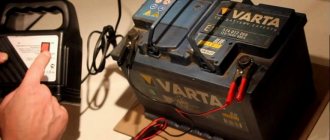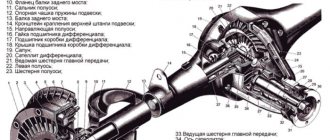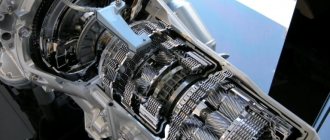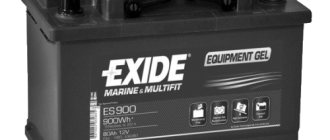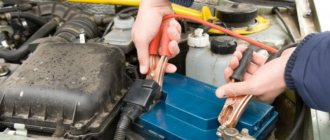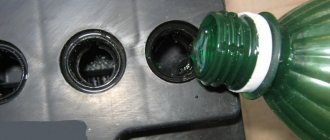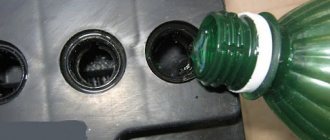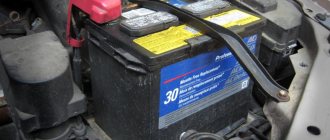- The presence of antimony additive in the electrodes improves strength and casting properties, but increases the tendency to gas formation at high charging currents.
- The need for regular monitoring of the electrolyte level and density.
- High self-discharge value.
- Risk of shedding of the active mass of the electrodes.
Replacing antimony in the alloy with calcium and other metals helped reduce the negative qualities. Maintenance-free calcium batteries do not require regular monitoring, but they have a number of disadvantages:
- The stability of the onboard voltage must be high (no more than 0.1V).
- Deep discharge of the battery is not allowed.
- It is difficult to control the state of the electrolyte.
Based on the above, it is sometimes difficult to choose a serviced or maintenance-free battery for your car.
Maintenance-free car battery design
There are no fundamental differences in the designs of lead-acid batteries. Only the production technology differs. Maintenance-free batteries are made from materials of high purity with a change in the composition of the alloy of the electrode plates.
Thanks to the fact that it was possible to reduce gas emission (electrolytic decomposition of electrolyte water), it became possible to seal the battery case. As a result:
- there are no losses due to water evaporation;
- surface self-discharge reduced to a minimum
- additional cavities under the electrodes prevent falling sludge from short-circuiting the plates.
How to open the battery cover
Serviceable batteries have plugs for checking the cans. Getting to the contents of a maintenance-free battery is more difficult. There are no plugs, and the monolithic lid is a labyrinth for trapping and condensing vapors. Disruption of the labyrinth's passages will reduce the efficiency of the system. Therefore, before opening the battery cover, you need to weigh the pros and cons.
Attention! Before opening and checking the battery, it must be charged! The density of the electrolyte on a discharged battery is significantly lower!
Here are some options for how to get to the electrolyte:
Flaws
The most significant drawback inherent in maintenance-free batteries is the high requirements for the stability of the on-board network voltage. This requirement is a consequence of the fact that calcium batteries do not allow deep discharge, thereby losing their capacity.
Systematic undercharging during short trips in winter leads to the fact that after a number of successive starts of the starter, the EMF level approaches the minimum permissible, and the generator voltage is reduced due to the large number of consumers (heated mirrors and seats, headlights, heater operation). Before installing a maintenance-free battery in a car, you should make sure that the generator has the necessary power reserve and that the stability of the on-board network voltage does not go beyond the specified limits.
Even worse for such batteries is high voltage. Towards the end of the charge, no matter what quality the batteries have, the moment of electrolysis of water in the electrolyte comes. In a sealed case of maintenance-free batteries, this can lead to swelling of the case, cracks, and leakage of electrolyte.
Types of batteries
There are several types of rechargeable batteries that do not require maintenance:
Examples of gel batteries.
- acid lead-calcium. Due to alloying, battery plates are more resistant to mechanical stress and corrosion. The batteries practically do not lose capacity (low self-discharge), the electrolyte does not “boil” in them;
- acid AGM batteries. A special feature is the electrolyte placed in special fiberglass woven mats. These types of batteries are resistant to deep discharge, and practically no sulfate film (sulfation) forms on their plates. As a result, a service life of up to 10 years;
- EFB. Improved models, characterized by increased thickness. Their plates are wrapped in a special material impregnated with electrolyte, which reduces the likelihood of sulfation. Service life – from 5 to 10 years;
- GEL. The electrolyte in these batteries is not liquid, but gel-like, that is, it is in a bound state. Highly reliable models that can withstand low temperatures well, but require stable on-board voltage and are expensive.
Of all these types, only lead-calcium can be restored. However, there are craftsmen on the Internet who “reanimate” GEL models, but this is at your own peril and risk.
Which is better, a regular battery or a maintenance-free one?
If the car meets the listed requirements, then the answer is clear, the new calcium battery is much better. Such batteries relieve the car owner of some of the responsibilities and improve the reliability of starting the car.
Another thing is a car with an outdated on-board power supply system. Old domestic and foreign models with a relay voltage regulation system do not provide the necessary stabilization of the charge current at the battery terminals. As a result, either undercharging or overcharging occurs with all the ensuing consequences. Servicing new batteries is difficult or impossible. At the same time, batteries often do not even fulfill their warranty period.
Charging process
The battery should be charged periodically using a special charger. Most cars have an on-board voltage of about 14.4 V. This value was chosen because too high a voltage speeds up the process of water evaporation. When charging from a network device, you must maintain a voltage level of no higher than 15.5 V. Features of the charging process:
- When choosing a charger, you should give preference to models that have an automatic control unit. The charging process in this case eliminates the possibility of damage to the battery.
- Commands to change current and voltage are given by the electrical unit of the charger.
- In the process of replenishing the charge level, chemical reactions take place, leading to the release of harmful substances. That is why it is recommended to carry out the charging process in a well-ventilated area. Too high a concentration of gases released can be harmful.
Such chargers are expensive . This is why chargers with a manual control unit are often found in garages:
Maintaining a Maintenance Free Battery
To quickly monitor the condition of maintenance-free batteries, manufacturers equip them with a special indicator, which can be used to approximately estimate the degree of charge and electrolyte level.
Attention! By the presence of an indicator (eye), you can distinguish a maintenance-free battery from a regular one.
It is important to know that the indicator displays the status of only one of the cans, mainly the central one. What happens in the remaining ones is unknown. If the indicator shows a low charge level, the battery must be recharged using a charger with good stability of output voltage and charging current.
The only accessible and reliable method for checking a maintenance-free battery is to measure the EMF with a load fork. Simply measuring voltage with a voltmeter does not provide the necessary accuracy, since it does not take into account the internal resistance of the battery. In the load plug, a load of high-resistance wire is connected in parallel to the terminals of the voltmeter. The load resistance corresponds to the rated discharge current of the battery.
A reduced voltage level with normal indicator readings indicates a malfunction in one of the cans.
Most conventional electrolyte monitoring methods void the product warranty because the sealed housing prevents access to the battery cells to determine their condition.
Battery life
Today, out of every five new batteries for special equipment and passenger cars that go on sale, four are maintenance-free. Therefore, thinking about “which battery is better” leads to the conclusion that this option is more preferable. Because if banks are operated correctly, they work for a long time and reliably.
Maintained batteries, if treated properly, can operate without problems for two to three years. Whereas unmaintained - from five to seven years. Their warranty alone is 24-36 months.
True, there is one subtlety here. It is necessary to choose reliable sealed batteries from well-known companies. Because if you buy an inexpensive maintenance-free power source, then most likely it will work for the same 2-3 years as a serviced one. And then problems begin, because thin lead plates are placed on such products. They begin to deteriorate faster than those that are made “as expected.” There is nothing to be done, saving, pursuing profit... And in general, “third grade is not a waste.” By the way, this is why the warranty on cheap batteries does not exceed 1 year.
Adding water or electrolyte
In order to add water to a maintenance-free battery or measure the electrolyte density, you need to gain access to individual banks. Some manufacturers cover the caps of the jars with a decorative lid. In essence, such batteries are no different in design from classic, maintenance-free ones, and normal maintenance methods are applicable to them. If the cover is glued, it can be carefully removed from the body and then glued again.
It’s worse if the lid is welded monolithically to the body. In this case, opening a maintenance-free battery is much more difficult. You can make holes opposite the filler necks. After servicing, the holes are closed with hermetically sealed suitable caps.
Attention! When drilling holes, it is important to prevent chips from getting into the electrolyte. To do this, pre-drill holes with a drill of a smaller diameter.
It is safer to use a large volume syringe. When using a syringe, the diameter of the holes does not exceed 1 mm. In order to determine the electrolyte level, the syringe needle is gradually lowered into the hole, while simultaneously extending the rod. When electrolyte begins to be sucked into the needle, mark the level on the needle. The same actions are performed for all battery jars.
To check the density, part of the electrolyte is drawn into a syringe and poured into a suitable container, from which it is convenient to draw for measuring the density with a hydrometer. We must remember to return the tested electrolyte to the same jar from which it was removed.
When the electrolyte level is low, distilled water is poured into the jars, and in the case when it is necessary to increase the density, for example, when switching to winter mode, then a correction electrolyte with a density of 1.4 g/cm3 is added. In this case, it may be necessary to select part of the electrolyte so that the final level does not exceed the permissible level.
After manipulating the electrolyte, the battery is charged in order to naturally mix the liquid medium. Turning the battery over to drain the electrolyte or mix it is strictly prohibited, as the electrodes will short-circuit with the crumbling sludge.
The containers in which the electrolyte will be located must be made of glass, ceramics or plastic. The use of metal utensils is not allowed, since the electrolyte is a chemically active medium and reacts with most metals. The stainless steel from which the syringe needle is made is an exception.
What tools are needed for opening
To gain access to the filler holes, even if they are filled at the factory to the surface level of the case, you must remove the cover from the battery. How to open the battery cover? If it is on the grooves, then carefully unclip the fasteners and remove the element. You may need a flathead screwdriver.
A hot pressed part will not come off easily. During its dismantling, there is a high probability of the part breaking. Therefore, we do not recommend removing this type of element. However, if you wish, you can try to break the integrity of the part using an awl, screwdriver or drill. You will not remove the cover completely, but you will be able to make holes for further operations.
Battery recovery
If necessary, you can try to restore both regular and maintenance-free batteries, since they have the same faults. The loss of capacity and uneven change in density in individual banks is restored in maintenance-free batteries through several cycles of charge and discharge with rated currents. Such actions help to dissolve large crystals of lead sulfate, which reduce the amount of active substance necessary for the chemical reaction to occur.
Safety precautions
- We strongly recommend using protective equipment when disassembling the power supply. It is strictly forbidden to turn over or shake the jars. This may cause a short circuit.
- If the battery cover is secured with fasteners, be careful not to break them. In the event of a breakdown, the part will have to be glued, and this does not guarantee safe operation of the power source.
- If you want to split the battery using a tool, choose special products that will help protect your eyes from splinters.
Can we safely say that a maintenance-free battery can be made into a serviceable one? Of course, a closed battery can be remade! If the purpose of opening the battery is to extract lead for fishing or hunting, then by observing a number of precautions, you can easily do it with just a hammer.
